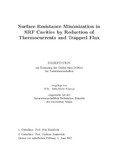Citation link:
https://nbn-resolving.org/urn:nbn:de:hbz:467-12208Files in This Item:
| File | Description | Size | Format | |
|---|---|---|---|---|
| Dissertation_Julia_Marie_Koeszegi.pdf | 39.48 MB | Adobe PDF |  View/Open |
| Dokument Type: | Doctoral Thesis | metadata.dc.title: | Surface resistance minimization in SRF cavities by reduction of thermocurrents and trapped flux Minimierung des Oberflächenwiderstandes supraleitender HF Resonatoren durch Reduzieren von Thermoströmen und eingefangenem Magnetfluss |
Authors: | Köszegi, Julia-Marie | Institute: | Fakultät IV - Naturwissenschaftlich-Technische Fakultät | Free keywords: | superconductor, particle accelerator, magnetic flux, thermoelectric effect, cavity | Dewey Decimal Classification: | 530 Physik | GHBS-Clases: | UDWD UDWP UHYA |
Issue Date: | 2016 | Publish Date: | 2017 | Abstract: | Eingefrorener magnetischer Fluss ist eine bekannte Ursache der hochfrequenz (HF) Verluste in supraleitenden HF Resonatoren für Teilchenbeschleuniger. Insbesondere für neue Beschleuniger, die mit hohen Feldern im Dauerstrichbetrieb arbeiten, können diese Verluste sowohl von einem betrieblichen als auch einem wirtschaftlichem Gesichtspunkt her unakzeptabel hoch werden. Wie jüngste Messungen zeigen, hat die Abkühlprozedur, mit der SHF Resonatoren auf Betriebstemperatur gebracht werden, einen deutlichen Einfluss auf den Oberflächenwiderstand des Niobs und damit die HF Verluste. Wir haben einen direkten Zusammenhang zwischen den Temperaturunterschieden während des Abkühlens und dem Oberflächenwiderstand gefunden. Die vermutliche Ursache hierfür sind Thermoströme, die während des Abkühlvorgangs im System aus Niobresonator und dem aus Titan gefertigtem Heliumtank entstehen. Diese Ströme generieren ein Magnetfeld, das im Material während des supraleitenden Phasenübergangs eingefroren wird. Um die Thermoströme zu quantifizieren wurden die Seebeck-Koeffizienten von Niob und Titan im Temperaturbereich von 10K bis 100K gemessen. Auf dieser Grundlage wurden numerische Simulationen des Resonatorsystems durchgeführt und aus der errechneten Stromverteilung anschließend das Magnetfeld an der HF Oberfläche bestimmt. Dieses hing kritisch von der Temperaturverteilung im System ab. Eine direkte Messung des eingefrorenen Flusses bestätigte die Ergebnisse der Simulationen und war konsistent mit dem ermittelten Anstieg des Oberflächenwiderstandes. Die Menge des tatsächlich eingefrorenen Flusses hängt außerdem stark von den Abkühlbedingungen ab. Aktuelle Studien zu diesem Thema, einschließlich experimenteller Ergebnisse anderer Gruppen und einer theoretischen Beschreibung, wurden zusammengefasst und zwei ausgewählte Fragestellungen mit zusätzlichen Experimenten vertieft. Dafür wurde zum einen ein durch Wärmeleitung gekühlter Niobresonator untersucht. Hierbei wurde die Flussverdrägung durch gleichförmiges Abkühlen während des supraleitenden Phasenübergangs verbessert. Im Anschluss wurden magneto-optische Messungen durchgeführt um die unterschiedlich geformten Phasenfronten, zum einen während des Abkühlens und zum anderen während des Eindringens des Magnetfelds, sichbar zu machen. Die dabei identifizierten Unterschiede liefern einen wichtigen Ausgangspunkt für weiterführende Studien zur effektiven Flussverdrängung. Trapped magnetic flux is known to be a major cause of radio-frequency (RF) dissipation in superconducting RF cavities for particle accelerators. Especially in many new machines, which operate at high field in the continuous-wave mode, these additional losses can be unacceptably high, both from an operational and economic point of view. Recent measurements demonstrated that the procedure with which SRF cavities are cooled to the superconducting state dramatically impacts the niobium surface resistance which in turn governs the RF power dissipation. We found a direct correlation between the temperature difference during cooldown and the surface resistance. We believe that thermocurrents generated during the cooldown at the niobium cavity and the titanium tank, which holds the helium, generate a magnetic field. This field is subsequently trapped when the cavity transitions to the superconducting state. To determine the extent of thermocurrents, the thermopowers of niobium and titanium were measured in the temperature range from 10K to 100K. Numerical simulations of the cavity system were performed based on these results. The obtained current distribution was used to estimate the magnetic field at the RF surface of the cavity, which critically depends on the temperature profile of the cavity. Direct measurements of the trapped flux confirmed the simulations and were consistent with the observed increase in surface resistance. The extent to which the magnetic flux is actually trapped also depends on the cooldown conditions. Recent experimental findings, including those of other groups and a theoretical description, were compiled. Two selected topics were addressed by additional measurements. For one, we studied the flux expulsion in a conduction-cooled cavity and found that it is favored by a homogenous temperature profile during the superconducting transition. Secondly, we used magneto-optical studies to visualize the different shapes of the superconducting phase front during either cooldown or during field penetration. The results provide important starting points for further investigations of flux expulsion. |
URN: | urn:nbn:de:hbz:467-12208 | URI: | https://dspace.ub.uni-siegen.de/handle/ubsi/1220 | License: | https://dspace.ub.uni-siegen.de/static/license.txt |
| Appears in Collections: | Hochschulschriften |
This item is protected by original copyright |
Page view(s)
633
checked on Nov 29, 2024
Download(s)
435
checked on Nov 29, 2024
Google ScholarTM
Check
Items in DSpace are protected by copyright, with all rights reserved, unless otherwise indicated.

